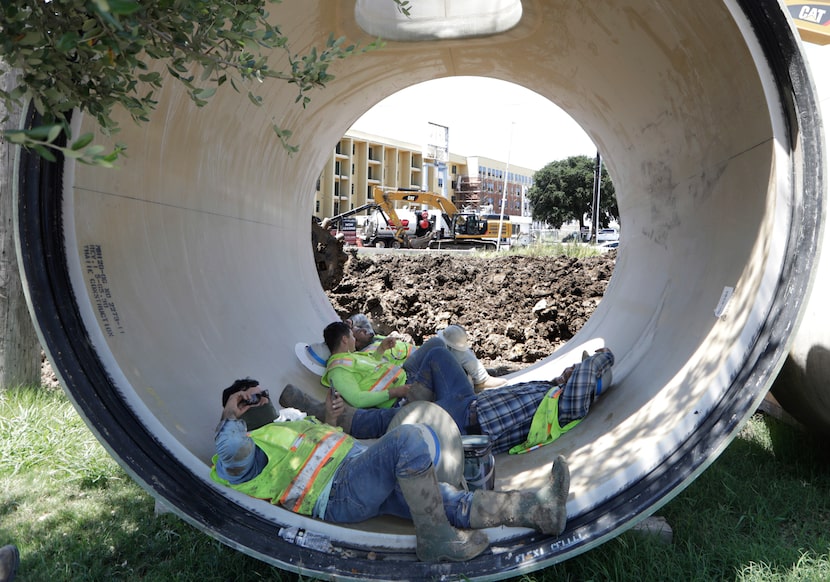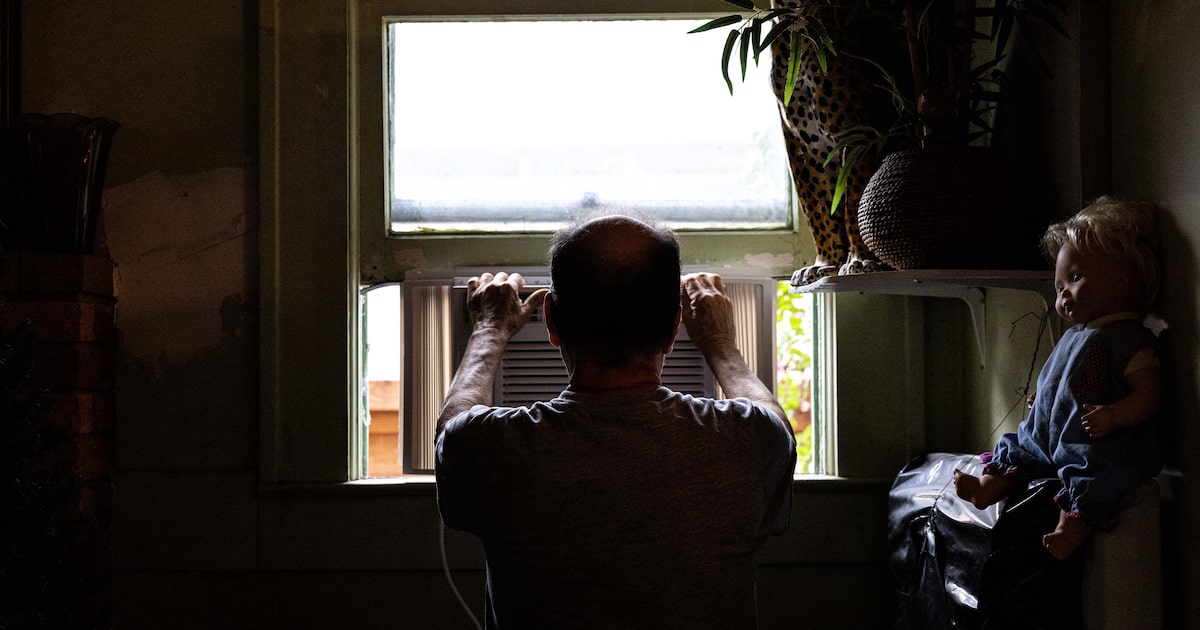Extreme heat in North Texas poses a deadly health risk to its workforce and could also harm the region’s economy, according to several studies by local and national economists.
As North Texans brace for another abnormally hot summer, soaring temperatures have become more common and intense, impacting quality of life in myriad ways.
From health outcomes to labor productivity to air quality and infrastructure development, the effects of severe heat are wide-ranging, yet lawmakers’ efforts to mitigate them are still meager.
The impact of climate change is inescapable and if left to boil over, extreme summers may affect North Texas’ emergence as a global financial hub and even reverse its fortunes, according to economists, climatologists and climate researchers.
Breaking News
Extreme summer heat in 2023 cost the state an estimated $24 billion in total finished goods and services produced, or a full percentage point of GDP growth, according to economists with the Federal Reserve Bank of Dallas.
Extreme heat, the study found, may be particularly damaging to Texas’ economy.
“The impact of an increase in summer temperatures on Texas GDP growth is twice as pronounced as the change in the rest of the U.S., because summers here are generally hotter relative to the rest of the country,” according to economists Aparna Jayashankar, Prithvi Kalkunte, Anil Kumar and Pia Orrenius, who authored the study.
Impact on health and economy
In the summer of 2024, Dallas County recorded at least eight deaths and 1,123 emergency department visits for heat-related illnesses, according to Dallas County Health and Human Services. These visits included cases of heat exhaustion, cramps, sun stroke and other health problems.
Adults in the working age group of 18 to 64 years old accounted for almost 80% of these visits, according to the department’s database.
In 2023, when temperatures hit record highs, the county linked at least 31 deaths and about 2,250 emergency department cases to extreme heat exposure.
That same year, Ray Perryman, a Waco-based economist and CEO of the Perryman Group, estimated net losses of $9.55 billion in real gross product to the Texas economy or a reduction in growth of about 0.47%.
Exposure to record heat temperatures increases morbidity and mortality impacting productivity, agricultural yields and other major sectors such as finance and insurance, Perryman said.
“These losses are partially offset by gains in other sectors, such as increases in utility consumption,” he said, “but on balance, extreme heat has negative consequences for human health and the economy.”
By 2050, the long-term impacts of higher than average summer temperatures will cost the state economy losses of almost $400 billion in real gross product, according to Perryman’s projections.
This does not include the extra costs of health care, Perryman said.
While a typical summer costs Texas $85 million in additional health care expenses for heat exposure-related ER visits, hospitalizations and outpatient treatments, Perryman said extreme temperatures in 2023 and 2024 hiked these expenses by an average $20 million each year.
The costs of workers’ lost earnings and quality of life would be even higher, he said.
The economy can adapt, according to the Dallas Fed economists.
Aside from city-issued heat advisories and cooling stations, businesses can set up additional tents and cabanas for shade, alter production schedules and adopt other such measures to mitigate the impact of heat on their workers.
Communities can adapt, they wrote, by creating walkable neighborhoods and retrofitting homes with sustainable technologies that ease the burden while preserving the power grid.
Impact on workforce
About 25% of the Dallas-Fort Worth workforce is involved in outdoor work, according to the Union of Concerned Scientists’ Too Hot to Work report.
This includes jobs in construction and extraction, maintenance and repair, transportation, moving materials and public safety, including firefighters and police officers.
 Thalle Construction Company workers Prudencio Guevara-Rangel (left), Oscar Perez, Alberto Cardenas and Jose Martinez (far right) sought refuge from the heat in a large pipe during their lunch break on Wednesday, June 28, 2023, near the intersection of N. Riverfront Blvd and Continental Ave. in Dallas. The workers are currently putting in eleven-hour workdays and taking frequent water breaks in shaded areas to cope with the heat.(Irwin Thompson / Staff Photographer)
Thalle Construction Company workers Prudencio Guevara-Rangel (left), Oscar Perez, Alberto Cardenas and Jose Martinez (far right) sought refuge from the heat in a large pipe during their lunch break on Wednesday, June 28, 2023, near the intersection of N. Riverfront Blvd and Continental Ave. in Dallas. The workers are currently putting in eleven-hour workdays and taking frequent water breaks in shaded areas to cope with the heat.(Irwin Thompson / Staff Photographer)
Without worker protections in place, the time lost working on extremely hot days equals lost pay. For about a week each year, extremely hot temperatures put workers, many of whom are Black and Hispanic, at risk for earning losses due to unsafe working conditions and decreased production, according to the report.
“Since 2000, the number of 100-degree days in any given year has doubled or more — and it’s continuing to rise,” said John Nielsen-Gammon, Texas state climatologist and director of the Southern Regional Climate Center.
Researchers are still in the early days of understanding how extreme heat affects our regional economies, said Adi Tomer, a Brookings Institution research fellow focused on urban infrastructure and climate change.
“This is a growing metropolitan area requiring folks to work outside in the heat — not just for housing construction but roadway construction, commercial real estate and other infrastructure and services, ” Tomer said. “This kind of work is highly exposed and it’s going to continue to put more folks in harm’s way, so how is the state protecting them?”
Dr. Philip Huang, director of Dallas County Health and Human Services, said local efforts to protect workers from heat have been restricted by state laws.
In 2023, Gov. Greg Abbott signed a law — House Bill 2127, dubbed the “Death Star” bill by opponents — which overrides local ordinances in Austin and Dallas that guaranteed water breaks for workers.
“The Texas legislature, essentially arguing that a patchwork of regulations is problematic, has fought back against local ordinances designed to protect workers against excessive heat,” said Nielsen-Gammon.
“And that’s fine; it’s fine to have uniformity in regulation — but then you still have to do the piece where you’re protecting the health of workers and I haven’t seen that taken up by the legislature yet.”
Impact on neighborhoods
Some neighborhoods in Dallas are more at risk than others.
In 2024, the Centers for Disease Control and Prevention and the National Oceanic and Atmospheric Administration released a Heat and Health Index to identify which neighborhoods are most vulnerable,
Several parts of Texas, particularly the Dallas metropolitan area, feature in the top 10% of areas facing some of the most significant heat risks in the nation.
 Rose Jones, a medical anthropologist researching the impacts of extreme heat in the region, compiles narratives for publication in “Texas Tales: Life and Death in the Sun Belt” at her home office on Friday, July 18, 2025 in Lewisville. (Angela Piazza / Staff Photographer)
Rose Jones, a medical anthropologist researching the impacts of extreme heat in the region, compiles narratives for publication in “Texas Tales: Life and Death in the Sun Belt” at her home office on Friday, July 18, 2025 in Lewisville. (Angela Piazza / Staff Photographer)
“If Dallas is literally a national hot spot, the next question becomes, well, what are we doing about it?” said Rose Jones, a medical anthropologist researching extreme heat in Dallas.
At the ZIP code-level, the index predicts heat-related health risks based on an analysis of preexisting health conditions, sociodemographic factors and the neighborhood’s natural and built environment.
South Dallas, Cedar Crest, Oak Cliff and West Dallas were identified as most vulnerable. These neighborhoods are home to many lower income Black and Hispanic families already burdened with the lingering impacts of historical inequities and heavy pollution.
The CDC’s data is just the tip of the iceberg, Jones said. Heat-related illnesses and deaths, she added, remain vastly undercounted under the existing terms and conditions.
Record heat in combination with other pollutants aggravate health problems for people already burdened with chronic diseases. It is proven to lower air quality and increase Ozone pollution, impacting anyone going outside for prolonged periods on hot days.
“People have to go to work and they have no choice but to breathe this air every day and it’s hurting them,” said Caleb Roberts, executive director of Downwinders At Risk, a grassroots environmental justice organization working with communities in Southern Dallas.
To address these growing concerns, Roberts advocated for better protections against the industrial air pollution Dallas residents are frequently exposed to.
“If it keeps worsening every summer,” Roberts said, “it’s going to get increasingly tough to sustain our economy.”
 Caleb Roberts, executive director of Downwinders At Risk, leads a meeting on how to implement a federal grant to create and expand solar programs for low-income communities called Solar for All on Tuesday, July 15, 2025, in Dallas. Members of the environmental justice organization (from left) Esme Zuniga, Alicia Kendrick and Misti Oquinn brainstorm with Roberts.(Angela Piazza / Staff Photographer)
Caleb Roberts, executive director of Downwinders At Risk, leads a meeting on how to implement a federal grant to create and expand solar programs for low-income communities called Solar for All on Tuesday, July 15, 2025, in Dallas. Members of the environmental justice organization (from left) Esme Zuniga, Alicia Kendrick and Misti Oquinn brainstorm with Roberts.(Angela Piazza / Staff Photographer)
Mario Flores, 66, a resident of North Oak Cliff for over 25 years, said the heat exacerbates his preexisting medical conditions, forcing him to stay inside, away from the sun.
“The heat gives me a lot of anxiety,” he said. His wife, Rena, 61 chimed in, adding it also gives him headaches.
Flores used to work on remodeling homes in D-FW, and recently received an air conditioner through a “Beat the Heat” outreach event sponsored by Senior Source.
“I remember when I was young, we would ask each other, what would you prefer — the cold? or the heat? — and we always chose the heat,” Flores said. “The summers were beautiful then, it wasn’t too hot, the sun wasn’t too harsh — not like now.”
Flores said elected officials and policymakers need to invent a solution for the future. “Because in the next 20 to 25 years, it is going to be unbearable,” he said.
Oak Cliff resident Mario Flores copes with extreme heat in Dallas
 View GalleryPotential impacts on migration
View GalleryPotential impacts on migration
Not everyone can pack up and move to a less polluted, verdant neighborhood. But some do and this can bear significant economic consequences for the region.
Research from the Federal Reserve Bank of San Francisco predicts extreme heat will ultimately change migration patterns in the U.S. As global warming makes typically colder locations more livable, more folks will choose to escape the heat rather than suffer from it.
Studying data on the weather, population, employment, wages and housing prices from 1951 to 2020, San Francisco Fed economists Sylvain Leduc and Daniel Wilson, found that ongoing migration from the U.S. Snow Belt to the Sun Belt is weakening.
For now, data from the study show Texas, and in particular Dallas, Austin and Houston, are resistant to these changing trends. Growth in D-FW is still outpacing the average urban U.S. area, though overall population growth has slowed compared to previous decades.
“Somewhere,” Nielsen-Gammon said, “there’s a trade-off between days that are dangerously hot and days that are dangerously cold.”
Presumably, he said, as that balance changes, migration changes.
This reporting is part of the Future of North Texas, a community-funded journalism initiative supported by the Commit Partnership, Communities Foundation of Texas, The Dallas Foundation, the Dallas Mavericks, the Dallas Regional Chamber, Deedie Rose, the McCune-Losinger Family Fund, The Meadows Foundation, the Perot Foundation, the United Way of Metropolitan Dallas and the University of Texas at Dallas. The News retains full editorial control of this coverage.
